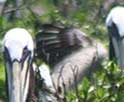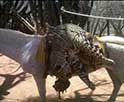White winged dove characteristics, habitad, facts and conservation
The White-winged Dove and Its Importance in the Ecosystem
Reading time : 1 minute,
Discovery Chepe Id-557-ECO
Published in
12-13-2024

Photo: Leigh Cooper
Pigeons, particularly the domestic pigeon, have demonstrated an astonishing ability to adapt to urban life due to the availability of food, abundance of nesting sites and, above all, the lack of natural predators.
The white-winged dove (Zenaida asiatica) is a species of columbiform bird noted for its elegant white wings and wide distribution in America. In this article, we will explore in detail its habitat, reproduction, feeding, conservation, and distinctive characteristics.
Habitat
The white-winged dove is an adaptable species that can be found in a variety of habitats, including:
1-Urban areas: Parks, gardens, and residential areas.
2-Rural areas: Agricultural fields, grasslands, and scrublands.
3-Deserts: Oases and areas with sparse vegetation.
Reproduction
The reproduction of the white-winged dove is a fascinating process. Pairs build simple nests using twigs and grasses. The female usually lays two white eggs. Both parents incubate the eggs and care for the chicks.

Why is the White-winged Dove Unique?
Photo: Jade
Food
The diet of the white-winged dove is quite varied and consists mainly of:
Seeds: From various plants, such as grains and herbs.
Fruits: Berries and fruits from trees and shrubs.
Insects: Especially during the breeding season.
Conservation
Although the white-winged dove is not in danger of extinction, it faces some threats such as:
Habitat loss: Due to urbanization and agriculture.
Pollution: From water and soil.
Hunting: In some regions.
Distinctive Features
The white-winged dove is characterized by:
Medium size: With an average length of 30 cm.
Plumage: Generally brownish-gray, with distinctive white wings.
Beak: Black and short.
Legs: Red.
The white-winged dove is a fascinating and adaptable species that has managed to coexist with humans in diverse environments. However, it is important to take measures to conserve its habitat and ensure its long-term survival.
The sounds that white doves make are a form of basic language that allows them to communicate and survive in their environment. They are not as complex as the songs of songbirds, but they serve vital functions for their species.
See Also
Discovery Chepe
Most read...















